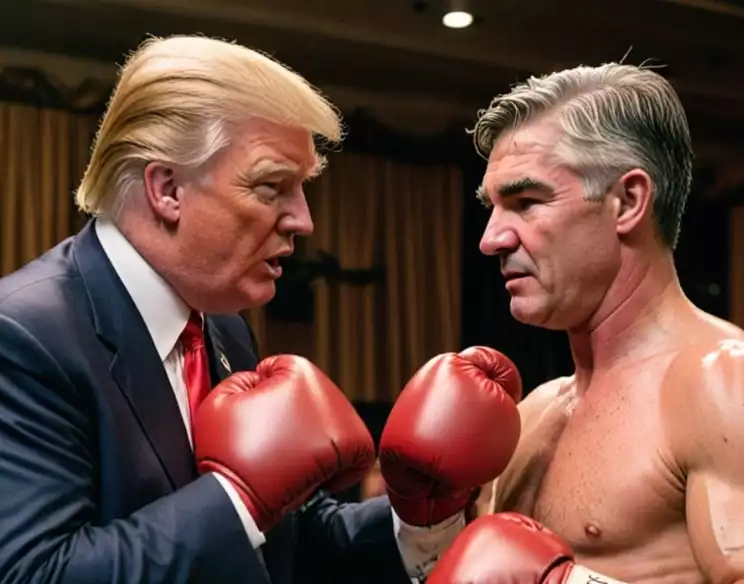Trump vs Fed: Round 2?
News
|
Posted 19/07/2024
|
1683
Trump's relationship with the Federal Reserve could, at best, be described as tumultuous. During his presidency he publicly criticised Powell and the Fed, and he strongly tried to steer their actions. If Trump is to win the upcoming election, Jerome Powell could be in for "round 2" with one of his greatest critics. But it looks like Powell just caught a break (maybe).
In a surprise twist, Trump made it clear this week in an interview with Bloomberg TV that he has no plans to fire Federal Reserve Chair Jerome Powell if he wins the presidency. This went directly against what many expected, not only for Trump, but also for his VP pick. Trump was previously a fan of devaluing the U.S. Dollar and saw it as a "gift", while J.D. Vance recently compounded this by saying that a weak U.S. Dollar would help U.S. exports. Powell's incessant battle against inflation by holding rates high is the antithesis of typical Trumponomics, which emphasise low interest rates and the use of tariffs. Trump previously referred to Powell as the "enemy" and called the Fed's rate-hiking actions insane.
So why the change? The obvious reason is that if the Fed does a cut soon, it will lead to an economic boost before the presidential election. The boost would be perfectly timed to help Biden (or whoever is the Dem's frontrunner at that time) by potentially making the stock market soar higher and putting more money in people's pockets. For seemingly this reason alone, Powell and Trump seemed to agree on something.
Another Problem Emerges
So, Trump is okay with holding high for a few months. Now, the problem is the Fed is looking almost unanimous in their pivot back to cutting. This situation could become a serious problem, as markets are currently betting on a rate cut literally weeks before the election, with traders pricing in a more than 90% chance of this happening.

-Ai Image
A September rate cut could attract political criticism from both Trump and other lawmakers. During recent Congressional testimony, Fed Chair Jerome Powell faced hints from both Republican and Democratic lawmakers that they would be critical if the September decision did not align with their expectations. Powell emphasised that the Fed remains focused on data regarding prices and jobs, maintaining an apolitical approach. But, with a potential cut coming weeks before an election in the face of already mounting criticism, they may face some political heat.
Despite Trump’s new stance and Powell's previous diamond hand hold on high rates, Federal Reserve officials have said that the time for rate cuts is approaching. In a speech that was literally titled "Getting Closer," Fed Governor Chris Waller indicated that while the final decision has not been reached, the data suggests that a rate cut may soon be on the cards. Evidence shows that disappointing inflation data from the first quarter of the year may have simply been an anomaly, with more recent data indicating healthy progress towards the Fed's 2% inflation goal. NY Fed President John Williams agreed, suggesting that an interest rate cut could be justified in the coming months if the slowdown in inflation stays on course. Williams did note not to expect a cut at their next meeting in July, however.
Waller outlined two scenarios that could lead to a rate cut. In the optimistic scenario, consistent favourable inflation reports could prompt a cut in the near future. In the more likely scenario, where inflation data remains uneven but shows overall progress, the timing of a rate cut would be more uncertain. Waller also expressed optimism about the U.S. economy achieving a soft landing, though he acknowledged potential risks to the job market. He emphasised that his role is to focus on economic data and make decisions to achieve the dual mandate given by Congress, not to factor in political developments.
Powell also noted the recent turnaround in inflation readings. The CPI showed encouraging numbers for June, and the Core CPI, excluding volatile food and energy prices, rose at a slower pace of 3.3% year-over-year. The Fed is set to receive new data from Core Personal Consumption Expenditures Index, on July 26.
Trump's prospect of a future presidency is still in the air, and he may not get what he wants from Powell. If he does win, one may expect him to allow Powell to stick around until his term ends in 2026 (since he will be in rate-cut mode anyway), then appoint a Fed chair that is more in tune with his Trumponomics. All scenarios have one thing in common: Devaluing the currency to create temporary prosperity.